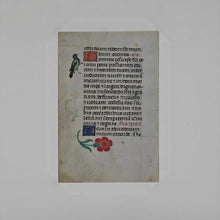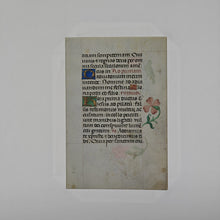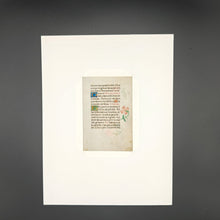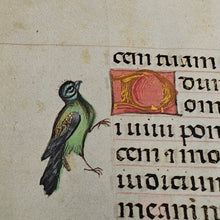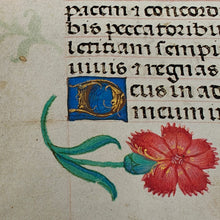
Bruges or Ghent, ca. 1500. Possibly attributable to Cornelia van Wulfschkercke. (125 x 85 mm) Latin. Single leaf from Book of Hours. Single column with two 2-line initials on recto and verso with decorative gilt penwork on coloured backgrounds of pink, blue and green; one 1-line initial in same style. 17 lines of Gothic rotunda with uncrossed Tironian et, hairlines on a and decorative hairlines on large initials, some ascenders have thorns and bifurcations, some descenders have bifucations. Gothic formata elements such as diamond pedes, but letter forms are rounded rather than typical Gothic angular form and less severe fusion throughout. Penstroke crosshatches at end of lines indicating broken words. Rubricated in pink. Recto begins Prime for the Hours of the Cross, likely Use of Rome. Marginal illustration of greenfinch, red carnation (dianthus), and stock (matthiola incana). High quality, thin and creamy parchment with minor marginal browning. Housed in passepartout, unmounted. German description in modern pencil along bottom border of passepartout, with numbers 124/873/3. Likely from the collection of Roger Martin (1939-2020).
About the artist and the parent book:
This leaf likely comes from a now-dispersed Book of Hours produced around 1500 to 1510 in Ghent or Bruges, with illustrations by a noted Carmelite nun, Cornelia van Wulfschkercke of the Sion convent (as identified by A. M. W. As-Vijvers). Cornelia entered the convent of Sion by 1495, took her vows shortly after the turn of the century, and became an important figure in the production of manuscripts in the Bruges/Ghent region. Cornelia produced around 23 known devotional books, both from her own hand and from her workshop for patrons within the monastic community as well as lay-patrons.
Previous auction records indicate that the parent book was owned by a private Dutch collector before 1995 but its leaves had been dispersed throughout Europe by the time Roger Martin set about to collect as many of them as possible in 1999.
About the Text (Prime of the Hours of the Cross):
This illuminated leaf comes from the Prime of the Hours of the Cross, a devotional Office that became a standard feature of Books of Hours from the late 14th through the mid-16th century. Typically paired with the Hours of the Holy Spirit, the Hours of the Cross trace the Passion across the canonical hours using stanzas from the hymn Patris sapientia veritas divina, each followed by a fixed versicle and collect. Though later rubrics attribute its composition to Pope John XXII (r.1316–34), this likely reflects indulgences granted for its recitation rather than authorship.
The present leaf preserves text from the conclusion of Matins and the opening of Prime, introduced by two 2-line initials in gold on red, blue, and green grounds. The text is laid out in a gothic rotunda bookhand (a bit more rounded than its well-known angular palaeographic sibling), ruled in pink ink, with generous margins. The decoration includes a greenfinch songbird rarely seen in manuscript illustrations, alongside a red carnation and pink stock. Such foliate and avian borders are characteristic of northern French and Netherlandish production ca. 1470 into the early 1500s— not quite a strewn border, but similar.
Like many examples, the text here is abbreviated; the hymn stanzas and repeated prayers are indicated by incipits, economizing space and parchment. By the later 15th century, Books of Hours increasingly favoured the “sans rien requerir” format, in which each Hour was copied out in full for ease of lay devotion. The Hours of the Cross, along with the Hours of the Holy Spirit, seems to have not been transmitted from devotional practice after the Council of Trent and neither appears in post-Tridentine printed books.
About the Flowers, the Bird, & Symbolic Meaning:
The red blossoms in the lower margin of the verso is a stylized carnation (Dianthus), a flower long associated with fidelity and affection. Known in English as “gillyflowers” or “sops-in-wine,” their clove-like scent and pale hues made them a favourite in both medieval gardens and betrothal imagery. Although they were common in Europe as wild cultivars, carnations were not mentioned as domesticated flowers until the 14th century.
The delicate four-petaled bloom on the recto is likely a stock or related crucifer, a group of sweet-scented flowers whose four-petaled forms naturally evoked the cross— fitting for one of the section of the Hours of the Cross. Such blossoms—often interpreted as dame’s violet (Hesperis matronalis) or honesty (Lunaria)—were closely linked to Marian and Passion symbolism in late medieval devotional culture.
While goldfinches have been (literally) counted as the most common small bird featured in illuminated manuscripts, other finches are far rarer. The most rare of the finches surveyed in medieval manuscripts, with only two accounted for in the Ormesby Psalter (Bodleian MS. Douce 366) and only a few possible ones in an early 15th century French manuscript. The bird on this manuscript is very likely to be another example of the rare greenfinch and displays notable similarities to the Ormesby Psalter greenfinches.
The overall aspect of this leaf is quite similar to Walters Ms. W.427, ca. 1500 Bruges/Ghent Book of Hours, illuminated with significant influence from the Master of the Prayerbooks, the Master of the Dresden Prayerbook, and the Master of the David Scenes.
Work cited:
Fisher, Celia. The Medieval Flower Book. The British Library Press, 2007.
Yapp, Brunsdon. Birds in Medieval Manuscripts. Schocken Books, 1982.
As-Vijvers, Anne Margreet W. “Manuscript Production in a Carmelite Convent: The Case of Cornelia van Wulfschkercke,” Books of Hours Reconsidered. Ed. Sandra Hindman and James Marrow, Harvey Miller Publishers, 2013.





